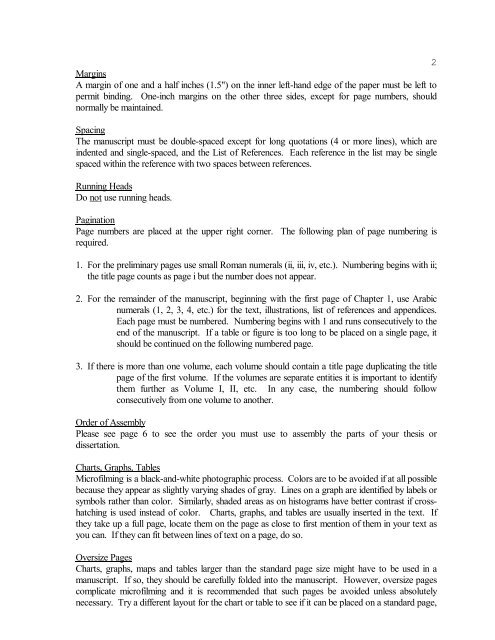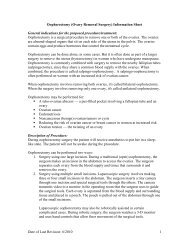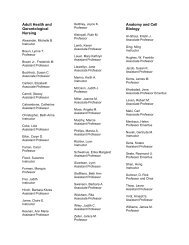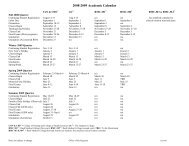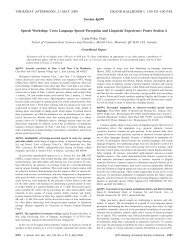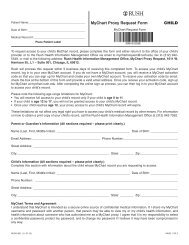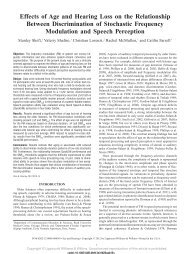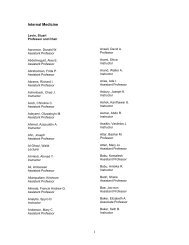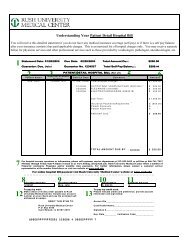RUSH UNIVERSITY GUIDE for PREPARATION OF ...
RUSH UNIVERSITY GUIDE for PREPARATION OF ...
RUSH UNIVERSITY GUIDE for PREPARATION OF ...
You also want an ePaper? Increase the reach of your titles
YUMPU automatically turns print PDFs into web optimized ePapers that Google loves.
2<br />
Margins<br />
A margin of one and a half inches (1.5") on the inner lefthand edge of the paper must be left to<br />
permit binding. Oneinch margins on the other three sides, except <strong>for</strong> page numbers, should<br />
normally be maintained.<br />
Spacing<br />
The manuscript must be doublespaced except <strong>for</strong> long quotations (4 or more lines), which are<br />
indented and singlespaced, and the List of References. Each reference in the list may be single<br />
spaced within the reference with two spaces between references.<br />
Running Heads<br />
Do not use running heads.<br />
Pagination<br />
Page numbers are placed at the upper right corner. The following plan of page numbering is<br />
required.<br />
1. For the preliminary pages use small Roman numerals (ii, iii, iv, etc.). Numbering begins with ii;<br />
the title page counts as page i but the number does not appear.<br />
2. For the remainder of the manuscript, beginning with the first page of Chapter 1, use Arabic<br />
numerals (1, 2, 3, 4, etc.) <strong>for</strong> the text, illustrations, list of references and appendices.<br />
Each page must be numbered. Numbering begins with 1 and runs consecutively to the<br />
end of the manuscript. If a table or figure is too long to be placed on a single page, it<br />
should be continued on the following numbered page.<br />
3. If there is more than one volume, each volume should contain a title page duplicating the title<br />
page of the first volume. If the volumes are separate entities it is important to identify<br />
them further as Volume I, II, etc. In any case, the numbering should follow<br />
consecutively from one volume to another.<br />
Order of Assembly<br />
Please see page 6 to see the order you must use to assembly the parts of your thesis or<br />
dissertation.<br />
Charts, Graphs, Tables<br />
Microfilming is a blackandwhite photographic process. Colors are to be avoided if at all possible<br />
because they appear as slightly varying shades of gray. Lines on a graph are identified by labels or<br />
symbols rather than color. Similarly, shaded areas as on histograms have better contrast if crosshatching<br />
is used instead of color. Charts, graphs, and tables are usually inserted in the text. If<br />
they take up a full page, locate them on the page as close to first mention of them in your text as<br />
you can. If they can fit between lines of text on a page, do so.<br />
Oversize Pages<br />
Charts, graphs, maps and tables larger than the standard page size might have to be used in a<br />
manuscript. If so, they should be carefully folded into the manuscript. However, oversize pages<br />
complicate microfilming and it is recommended that such pages be avoided unless absolutely<br />
necessary. Try a different layout <strong>for</strong> the chart or table to see if it can be placed on a standard page,


